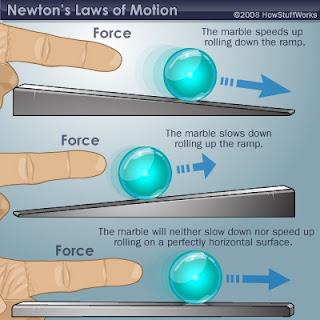In 1687 Newton published a book written , as was the routine in those days , in Latin and given the title , Philosophiae naturalis principia mathematica . Translated , this means , ” The mathematical principles of natural philosophy ” . The Principia , as it is familiarly called , is took to be one of the greatest scientific works ever written .
In the first part of the book Newton summarizes the basic priciples of motin in three laws . So , let’s hash out these laws and thier applications .
Newton’s first law of motion
Every body continues in its state of rest or of uniform motion in a straight line unless compelled by some external force to act otherwise .
If we place an object in a certain place we expect it to remain there unless a force is applied to it . Some simple parlour tricks are based on this principle . For example , if a pile of cents is placed on a table the bottom one can be removed without disturbing the remainder , simply by flicking it sharply with a piece of thin wood or metal. In this case the force of friction between the bottom disc and the one in contact with it acts for too short a time to cause any appreciable movement of the discs above . The bottle and coin trick is equally effective in demonstrating the same effect .
It is not immediately obvious that a body moving with uniform velocity in a straight line tends to go on moving for ever without coming to rest . The fact is that no one has yet found a means of eliminating all the various outside forces which can retard a moving body .
When a bullet is fired from a gun its motion is opposed by air resistance and the pull of the earth . Sooner or later it returns to the earth , but it would be sensible to suppose that , if air resistance and gravitation could be eliminated , the bullet would go on moving in a straight line for ever .
In the early seventeenth century the German astronomer , Johann Kepler, December 27, 1571 – November 15, 1630 , had shown that the planets move in elliptical orbits round the sun , but he was unable to explain why . It was left to Sir Isaac Newton to offer a acceptable explanation based on the first law of motion and the law of universal gravitation . Newton remonstrate that the planets move in curved paths because the sun is attracting them . No slowing up takes place, since there is no retarding force . The planets move in the vaccum of space , carrying their atmospheres with them . If the attraction of the sun suddenly ceased , a planet would continue to move in a straight line making a tangent with its original orbit .
It is important to realize that , once a body is moving with uniform speed in a straight line , it needs no force to keep it in motion provided there are no external opposing forces.
The tendency of a body to remain at rest or, if moving, to continue its motion in a straight line is described as inertia. For this reason, Newton’s first law is sometimes called “the law of inertia”.
Related posts:
Energy : Potential and kinetic energy , Conservation of energy , Forms of energy and Electrical ener...
Vectors: Scalar and Vector Quantities,Vector Addition: Graphical Method,Trigonometry, Pythagorean Th...
Equilibrium : Translational Equilibrium , Rotational Equilibrium , Center of Gravity and Finding a C...


